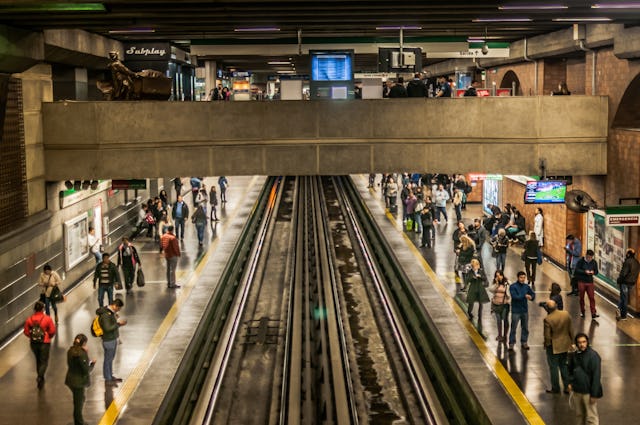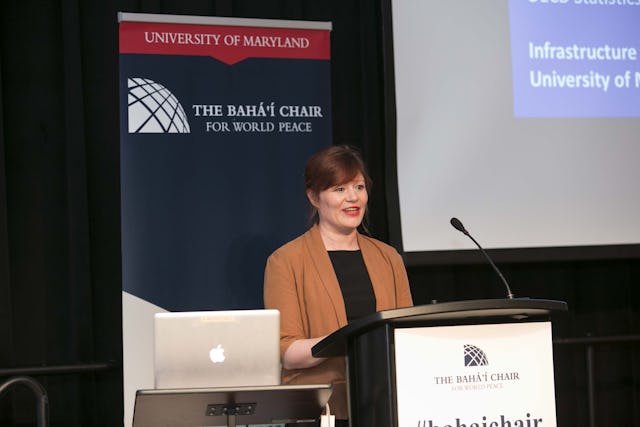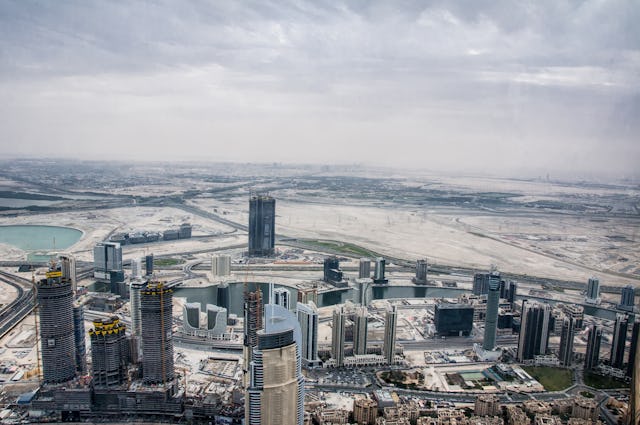Cities, technology, and happiness: a look at the future
COLLEGE PARK, MARYLAND, United States — Does city life make for happy citizens? What does a prosperous city look like? And what will be the values shaping cities in the future?
“In The Secret of Divine Civilization, ‘Abdu’l-Baha repeatedly uses ‘happiness’ to make a point about how leaders should develop political, economic, social, and cultural structures in order to advance the spiritual, material, and physical well-being of their citizens, to whom they are responsible,” says Hoda Mahmoudi, the current Holder of the Baha’i Chair for World Peace at the University of Maryland, College Park.
“Our most recent event brought to light how important happiness is to all aspects of human development and offered evidence-based results regarding the many factors that help to promote the happiness of people and society.”
Held on 4 and 5 April, the Baha’i Chair’s two-day conference brought together leading scholars and practitioners from diverse disciplines to better understand the dynamics of urban life. More than half the world’s population lives in urban areas, and the United Nations projects that this proportion will reach more than two-thirds by 2050. Concerned with the implications of this trend, speakers explored how urban infrastructure—from its physical elements such as buildings, highways, or power lines, to intangible ones such as social support, community organizations, or spirituality—affects the future of humanity.
One of the topics explored by presenters was whether happiness can be measured, and, if so, how.
Speaking to the conference’s attendees, Dr. Mahmoudi proposed that the concept of happiness is not merely an individualistic aim or a personal goal but a collective enrichment indicated by greater equity, inclusivity, access, health, security, and overall well-being. The subsequent talks looked at various dimensions of this broader conception of happiness.
“Any view of (the relationship between) infrastructure and happiness must contend with inequality in its myriad forms.”
—Carol Ryff, the Director of the Institute on Aging and a psychology professor at the University of Wisconsin-Madison
For instance, Carrie Exton from the Organization for Economic Cooperation and Development (OECD) argued that researchers and journalists interested in trying to gauge the prosperity of societies focus too much on gross domestic product, a measure of a country’s economic output, rather than on indicators of happiness and well-being. Dr. Exton’s work at the OECD has been to monitor happiness and progress in the 36 member countries as a way of determining societal well-being.
Carol Ryff, the Director of the Institute on Aging and a psychology professor at the University of Wisconsin-Madison, heads a major longitudinal study on health and well-being in which she studies 12,000 people in the United States. In her comments, Dr. Ryff noted the impact of the stark inequalities in American society today, arguing that greater attention needs to be given to this urgent matter. “Any view of (the relationship between) infrastructure and happiness must contend with inequality in its myriad forms. We must attend to the differential access to quality housing, schools, jobs, food, neighborhoods, and green space.”
Houssam Elokda, the Director of Operations and Masterplanning Lead with the Vancouver-based company Happy City, focused on how urban inequalities can be reinforced by a city’s transportation infrastructure. “When driving a car is the only mode of commute—the only option to access all the opportunities (of a city)—then you are telling those who can’t drive, … maybe they’re too poor, they’re too young, too old, or they have a disability, you are telling them that this city is not for them, that they are not meant to access these opportunities,” Mr. Elokda said.
Mr. Elokda also explained: research confirms that commuting by walking or riding a bicycle leads to greater happiness than commuting by car. To make this possible, however, cities need to invest to make these modes of transportation safer and more accessible to all residents, for instance, by building proper sidewalks, crosswalks, bike lanes, and other relevant infrastructure.
Evidence was also shown that cities, in part because of their infrastructure, can either restrict or facilitate residents’ participation in decision-making processes in their community. This can happen, for example, through “soft infrastructure,” such as laws, norms, and customs, explained Lok Sang Ho, the Dean of Business at Chu Hai College of Higher Education in Hong Kong. “We need to think about how to improve our institutions and cultural heritage so that they can be inclusive and positive in cultivating the values of love, fortitude, and engagement so that we all accumulate the spiritual capital that unites us,” Dr. Ho said.
Technology’s role in cities also featured prominently in the conference. For example, speakers explored how, as cities become filled with more digital technologies—from wireless Internet to self-driving cars to the ubiquitous presence of surveillance cameras—it will be important to think critically about the values underlying these technologies and whether they promote or restrict people’s agency. “You can actually encode values in the way you design the technology,” noted Ricardo Alvarez, a researcher with the Massachusetts Institute of Technology’s Senseable City Lab. “This is important because when you look at the large-scale systems that we’re putting together, it actually falls on us as society to frame the constraints and limits of a technology.”
The conference helped to highlight the interdisciplinary nature of the questions facing cities today. In reflecting on the interconnectedness of the planet, Dr. Mahmoudi later commented that the revolutionary changes affecting society must be seen through the lens of the oneness of humankind. “This vital principal is ‘not only applicable to the individual,’” she said, drawing on a well-known passage by Shoghi Effendi, “but is concerned primarily with the ‘nature of those essential relationships that must bind all the states and nations as members of one human family. It implies an organic change in the structure of present-day society.’”
Recordings of the talks can be found on the Baha’i Chair’s YouTube channel.


